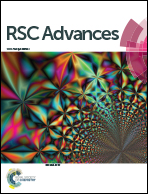Structural insight into inhibition of human Class II PI3K isoforms: homology modeling, binding site characterization, docking and molecular dynamics studies†
Abstract
Phosphoinositide-3-kinases (PI3Ks) are members of a large family of serine threonine kinases, which participate in important cellular events like cell survival, growth and proliferation. Among three classes, Class II PI3Ks have not been thoroughly investigated for their role in PI3K mediated signaling. In Class II PI3Ks, particularly PI3KC2α and PI3KC2β have been reported to play a role in cancer progression. Due to a lack of structural information, structure based drug design is not feasible for Class II PI3Ks. In the present study, we have constructed homology models of the kinase domain of Class II PI3Ks. Further using combined docking and molecular dynamics (MD) studies, we have investigated the binding mode of reported Class II PI3K inhibitors and their selectivity among Class II isoforms. We found that variations within and near the ATP binding site are responsible for the selectivity of Class II PI3Ks inhibitors. The present study highlights the utility of MD simulation in correct pose selection and will be helpful in guiding the design of selective inhibitors for the different members of Class II PI3Ks.


 Please wait while we load your content...
Please wait while we load your content...